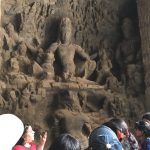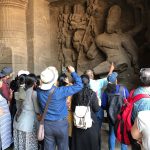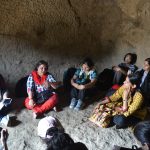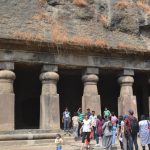-
At the Gateway !!
-
They arrive !
-
Students in rapt attention !!
-
Notes taking..
-
Story time !!
-
Look at that beauty !
-
Another story ??!!
-
The herd marches in..
-
One picture with the Trimurti.. oops !! with the Sadashiva !!
‘This is the Panchamukhi Shiva, also known as Sadāshiva,’ says Dr. Prachi Moghe, Assistant Director at the Bharatiya Vidya Bhawan and Visiting Faculty at the Mumbai University, pointing to the famous sculpture that many recognise as the Trimurti of Elephanta caves.
‘Panchamukhi?’ those gathered around her ask in surprise. ‘But there are only three faces!’
‘Yes!’ nods Dr. Moghe. ‘While three faces are carved into the wall, two faces are unseen!’
Facing the centre is the Sadāshiva, the Ultimate Divine Energy. While to the left is the Aghora-Shiva representing the divine power of dissolution, Vāmadeva to the right, represents the gentle form of sustenance. On the reverse and hence unseen, is the Tatpurusha-Shiva representing the power of concealment. And on the top and hence also unseen, is the Sadyojata-Shiva representing the power of creation.
While this sculpture of Shiva, was interpreted earlier as the Trimurti or the three faced Shiva, scholars today agree that it is not the Trimurti but the Panchamukhi Shiva.
‘This is the ultimate supreme form of Shiva,’ explains Dr. Moghe. ‘Through form, it symbolizes the formless, the Nirguna, the Nirākara.’
This Panchamukhi sculpture occupies centre-stage in the most prominent and richly decorated Cave No. 1 of the islands, amidst many forms of Shiva which have been etched into its walls.
While Natarāja maintains the cosmic balance with his splendid dance, Kalyānasundaram depicts how the ultimate can be attained through sādhana. While the Ardha-narīshwara Shiva teaches the world that both male and female principles are equally important, the Rāvana-anugraha Shiva reminds the devotee to always stay humble.
‘These caves are one of the three main sites of the Pashupata cult in Mumbai,’ points out Dr. Moghe as she explains the significance of this remnant of ancient history, not far from the shores of the commercial hub of India.
The Pashupata sect is one of the most ancient forms of Shaivism. Said to be founded by Lakulishā in the 2nd century CE, it is distinct and different from popular mainstream Shaivism.
While pasu refers to the individual soul, pati refers to the Lord and pasa are the fetters imposed on the soul keeping the individual soul from attaining the Divine. ‘When pasa is removed, the pasu can merge with the pati. This is the essence of the Pashupata cult.’ explains Dr. Moghe.
The caves were a live site of worship until the British period. Prior to that, when the Portuguese arrived here in the 16th century, they found two massive stone elephants on the island. This is how the place came to be known as the Elephanta islands. The Portuguese disfigured and destroyed many of the sculptures on the island, using them as targets for shooting practice. One of the stone elephants can be seen today outside the front entrance of the Bhau Daji Lad Museum in Mumbai.
‘Morā, Ghārā and Awas are the three sites of habitation on the island,’ explains Dr. Moghe. ‘The original name of the island is Ghārāpuri. Perhaps it was the capital of the Konkan Mauryas who ruled the region from the 2nd to the 3rd century CE.’ she adds.
Few people know that the Ghārāpuri island was an ancient site of entreport. Traders stopped at the port here since the 2nd century BCE for rest and to refill supplies of fresh water. Archaeological remains of Roman amphorae dating to those times have been found on the island.
‘The caves were also an ancient Buddhist site. British records mention the presence of a stupa on the eastern side of the island,’ says Dr. Moghe. ‘In fact, I have seen the plinth of the stupa about 20 years ago.’
But neither the stupa nor its plinth exist anymore. And that is a cause for concern.
‘This island has seen so much!’ says Dr. Moghe, ‘but very little work has been done to uncover, document and preserve that rich history!’
While boat-loads of people from Mumbai throng to the Ghārāpuri caves for a picnic, few seem to realise that they have stepped into a veritable time machine that transports them back into an era that existed 2000 years earlier.
So, take some time out to visit the Ghārāpuri islands and treat yourself to a passage into the past. And when you see the famous Panchamukhi Shiva at the centre of the Hall, you will know that what the eyes see, do not always represent the whole truth!
An article by Mallika Iyer, student of Diploma in Comparative Mythology course, in response to the study tour conducted by Dr.Prachi Moghe to the Gharapuri caves on 5th February 2017 for the course students.










Trackback 2